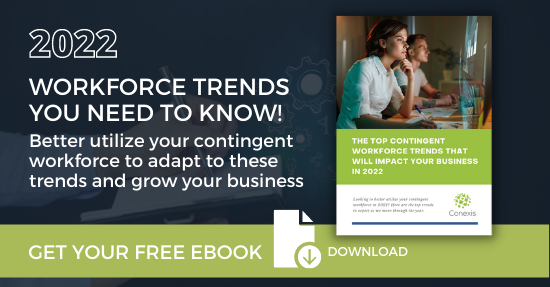Editor Note: To see an updated list of Contingent Workforce Stats 2025 please visit our blog at: 20 Contingent Workforce Statistics You Need to Know in 2025
The contingent workforce - which is made up of independent contractors, freelancers, temporary workers and consultants to name a few - has become a huge component of the way organization’s work in today’s world.
The benefits of contingent workers
In fact, most medium to large-sized organizations today rely on the ‘non-employee’ workforce to some extent - whether that be outsourcing work to freelancers during periods of high demand or supplementing their employee workforce with a group of contingent workers.
That’s because the contingent workforce staffing brings huge business benefits, from improved access to top talent, the ability to build an agile company that can easily adapt to market conditions, as well as reduced costs.
With that in mind, we’ve compiled a list of the top contingent workforce statistics in 2022 to show just how important the contingent workforce is to today’s businesses.
The growth of contingent workers
The contingent workforce has been rapidly expanding for a number of years, driven primarily by the Great Recession back in 2007. Many businesses now have a “full range” of contingent workforce spend, covering gig workers, temps, staff agencies, independent contractors and freelancers.
Due to its increase in use, the contingent workforce is no longer associated with just “non-core” business functions. Instead, the contingent workforce is also associated with highly-skilled workers that can provide value to many areas of a business.
- 82 percent of businesses expect an increase in the utilization of contingent labor through 2021 and 2022
(Workforce Logiq). - The average percentage of workers who are contingent is expected to grow to 24 percent in 2022, and to 29 percent by 2030 (Staffing Industry Analysts).
- Staffing agencies are experiencing an increase in the demand for contingent workers. Randstad, for example, jumped at least 20 percent year-on-year in 2021 as COVID-19 lockdowns were eased across the globe (Randstad).
- By 2050, it’s estimated 50 percent of the US workforce will be made up of freelance or contingent workers (US Government Accountability Office).
How businesses is shifting to contingent workers
Contingent workers have become a core component of many organization’s workforce in recent years, and for good reason. When utilized and managed correctly, contingent workers give a business access to top talent, fast, at competitive rates, and empower them to build a flexible and agile business that can be easily scaled depending on current requirements and market conditions.
Brian Kropp, Distinguished Vice President at Gartner, said in a report: “It’s critical for business leaders to understand that large-scale shifts are changing how people work and how business gets done. Leaders who respond effectively to these HR trends can ensure their organizations stand out from competitors.”
-
32 percent of organizations are replacing full-time employees with contingent workers as a cost-saving measure, and many others did so as a means to fill important skills gaps (Gartner).
The importance of a VMS for managing a contingent workforce
A vendor management system, also known as a VMS or VMS software, is a crucial element for any organization looking to successfully manage their contingent workforce and optimize the ROI they see from it.
Essentially, a VMS is a software platform that acts as a mechanism for businesses to manage and procure contingent workers, in addition to gaining visibility and control over the performance of the staffing agencies they use to source them.
A VMS enables greater control and visibility into a company’s global contingent workforce, and leads to soft savings through efficiency gains and cost savings through automation and more strategic processes.
- The vendor management system market is expected to grow between 7 to 11 percent by 2023 (Everest Group).
- 76 percent of companies had experienced savings through the use of a vendor management system (Staffing Industry Analysts).
The impact of the Great Resignation on Contingent Workers
Over the past year or so, the Great Resignation has posed a major challenge to the retention of workers and the acquisition of new talent for many businesses. In the current business environment, existing employees are difficult to retain and new employees are even more difficult to find.
The contingent workforce represents an opportunity for businesses to overcome that challenge, giving them fast access to top talent at competitive rates.
- Despite offices reopening, professionals are not excited to go back to the physical space. 34 percent of workers who were remote are not excited about returning to the office, compared to 24 percent who are (Upwork).
- In fact, the return to the office is fueling some of the Great Resignation. 17 percent of professionals that were working remotely during the pandemic would probably or definitely consider looking for another job if they have to go back to the office. This represents 9 million workers (Upwork).
- An increasing number of Americans quit their jobs in February and the gap between available positions and the unemployed grew even wider (Bureau of Labor Statistics).
- 20 percent, or 10 million Americans, are considering freelancing. Among those, 73 percent cite the ability to work remote or flexibly as a reason why (Upwork).
- The 10 million people considering freelancing would represent a significant 17 percent increase in the total freelance workforce when compared to the 57 million people that freelanced in all of 2019 (Upwork).
Discover the Power of Conexis VMS
Conexis VMS is purpose-built for organizations seeking to manage their contingent labor spend effectively. Here’s why we're the right choice:
- Fast Deployment: Get up and running in weeks, not months
- Transparent Pricing: Flexible pricing with no hidden costs
- White-Label Ready: Customize the platform with your brand
- Real-Time Insights: Make faster decisions with built-in analytics
- Audit-Ready Compliance: Store contracts, worker data, and rates in one secure hub
About Conexis VMS
Conexis is an award-winning Vendor Management System built for organizations that want the power of enterprise software without the complexity or cost.
Leveraging the latest technology, Conexis delivers the expertise, reliability and security of enterprise systems, while offering the flexibility, user friendliness and tailored, personal service you require. Learn more about our Company and why organizations Choose Conexis VMS.
Looking to Switch Your VMS or Just Getting Started?
Whether you are looking to Switch your VMS, or just Getting Started, we are here to help. Contact Us for a Free No-Obligation Consultation, See how Easy Conexis is to use by taking a quick 2 minute Self-Guided Online Demo, or Book a Personal Demo Today!


